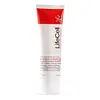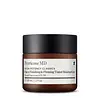What's inside
What's inside
 Key Ingredients
Key Ingredients

 Benefits
Benefits

 Concerns
Concerns

 Ingredients Side-by-side
Ingredients Side-by-side

Water
Skin ConditioningC12-15 Alkyl Benzoate
AntimicrobialAvena Sativa Kernel Extract
AbrasivePersea Gratissima Fruit Butter
EmollientButyrospermum Parkii Butter
Skin ConditioningCetearyl Alcohol
EmollientSilicon
AbrasiveTitanium Dioxide
Cosmetic ColorantGlycerin
HumectantDiethyl Ethanolamine
BufferingCetearyl Glucoside
EmulsifyingSclerotium Gum
Emulsion StabilisingIron Oxides
Thioctic Acid
AntioxidantTetrahydrobisdemethoxydiferuloylmethane
AntioxidantSpilanthes Acmella Flower Extract
Skin ConditioningRetinol
Skin ConditioningMalus Domestica Fruit Cell Culture Extract
Skin ConditioningMagnesium Ascorbyl Phosphate
AntioxidantGlycine Soja Oil
EmollientMagnesium Carbonate Hydroxide
BufferingCaprylic/Capric Triglyceride
MaskingHydroxyethyl Acrylate/Sodium Acryloyldimethyl Taurate Copolymer
Emulsion StabilisingPhenoxyethanol
PreservativeTribehenin
EmollientAcrylamide/Sodium Acryloyldimethyltaurate Copolymer
Emulsion StabilisingCeramide Ns
Skin ConditioningEthylhexylglycerin
Skin ConditioningPalmitoyl Oligopeptide
CleansingPalmitoyl Tetrapeptide-7
Skin ConditioningRetinyl Palmitate
Skin ConditioningPEG-10 Rapeseed Sterol
CleansingHesperidin Methyl Chalcone
AntioxidantSteareth-20
CleansingPalmitoyl Tripeptide-5
Skin ConditioningAcetyl Hexapeptide-8
HumectantDipeptide-2
Skin ConditioningCholecalciferol
Ubiquinone
AntioxidantTocopherol
AntioxidantTocopheryl Acetate
AntioxidantSodium Hyaluronate
HumectantZea Mays Oil
EmulsifyingAscorbyl Palmitate
AntioxidantWater, C12-15 Alkyl Benzoate, Avena Sativa Kernel Extract, Persea Gratissima Fruit Butter, Butyrospermum Parkii Butter, Cetearyl Alcohol, Silicon, Titanium Dioxide, Glycerin, Diethyl Ethanolamine, Cetearyl Glucoside, Sclerotium Gum, Iron Oxides, Thioctic Acid, Tetrahydrobisdemethoxydiferuloylmethane, Spilanthes Acmella Flower Extract, Retinol, Malus Domestica Fruit Cell Culture Extract, Magnesium Ascorbyl Phosphate, Glycine Soja Oil, Magnesium Carbonate Hydroxide, Caprylic/Capric Triglyceride, Hydroxyethyl Acrylate/Sodium Acryloyldimethyl Taurate Copolymer, Phenoxyethanol, Tribehenin, Acrylamide/Sodium Acryloyldimethyltaurate Copolymer, Ceramide Ns, Ethylhexylglycerin, Palmitoyl Oligopeptide, Palmitoyl Tetrapeptide-7, Retinyl Palmitate, PEG-10 Rapeseed Sterol, Hesperidin Methyl Chalcone, Steareth-20, Palmitoyl Tripeptide-5, Acetyl Hexapeptide-8, Dipeptide-2, Cholecalciferol, Ubiquinone, Tocopherol, Tocopheryl Acetate, Sodium Hyaluronate, Zea Mays Oil, Ascorbyl Palmitate
Titanium Dioxide 4.2%
Cosmetic ColorantWater
Skin ConditioningGlycerin
HumectantCyclopentasiloxane
EmollientDimethicone
EmollientPentylene Glycol
Skin ConditioningEthylhexyl Methoxycrylene
Skin ConditioningPolyester-8
Skin ConditioningPolyglyceryl-3 Polydimethylsiloxyethyl Dimethicone
Skin ConditioningHydroxyethyl Acrylate/Sodium Acryloyldimethyl Taurate Copolymer
Emulsion StabilisingBenzyl Alcohol
PerfumingAluminum Hydroxide
EmollientStearic Acid
CleansingCI 77491
Cosmetic ColorantCI 77492
Cosmetic ColorantCI 77499
Cosmetic ColorantDiethylhexyl Syringylidenemalonate
Skin ProtectingHydrogenated Lecithin
EmulsifyingCI 77891
Cosmetic ColorantIsohexadecane
EmollientBisabolol
MaskingMica
Cosmetic ColorantTetrahexyldecyl Ascorbate
AntioxidantPhenoxyethanol
PreservativeSilica Dimethyl Silylate
EmollientPolyester-1
Polysilicone-11
Polysorbate 60
EmulsifyingCaprylic/Capric Triglyceride
MaskingSodium Benzoate
MaskingPotassium Sorbate
PreservativeParfum
MaskingXanthan Gum
EmulsifyingHydrogenated Phosphatidylcholine
EmulsifyingCitronellol
PerfumingThioctic Acid
AntioxidantGeraniol
PerfumingAstaxanthin
Skin ConditioningHydroxycitronellal
PerfumingButylphenyl Methylpropional
PerfumingTitanium Dioxide 4.2%, Water, Glycerin, Cyclopentasiloxane, Dimethicone, Pentylene Glycol, Ethylhexyl Methoxycrylene, Polyester-8, Polyglyceryl-3 Polydimethylsiloxyethyl Dimethicone, Hydroxyethyl Acrylate/Sodium Acryloyldimethyl Taurate Copolymer, Benzyl Alcohol, Aluminum Hydroxide, Stearic Acid, CI 77491, CI 77492, CI 77499, Diethylhexyl Syringylidenemalonate, Hydrogenated Lecithin, CI 77891, Isohexadecane, Bisabolol, Mica, Tetrahexyldecyl Ascorbate, Phenoxyethanol, Silica Dimethyl Silylate, Polyester-1, Polysilicone-11, Polysorbate 60, Caprylic/Capric Triglyceride, Sodium Benzoate, Potassium Sorbate, Parfum, Xanthan Gum, Hydrogenated Phosphatidylcholine, Citronellol, Thioctic Acid, Geraniol, Astaxanthin, Hydroxycitronellal, Butylphenyl Methylpropional
Alternatives
Ingredients Explained
These ingredients are found in both products.
Ingredients higher up in an ingredient list are typically present in a larger amount.
This ingredient is an emollient, solvent, and texture enhancer. It is considered a skin-softener by helping the skin prevent moisture loss.
It helps thicken a product's formula and makes it easier to spread by dissolving clumping compounds.
Caprylic Triglyceride is made by combining glycerin with coconut oil, forming a clear liquid.
While there is an assumption Caprylic Triglyceride can clog pores due to it being derived from coconut oil, there is no research supporting this.
Learn more about Caprylic/Capric TriglycerideGlycerin is already naturally found in your skin. It helps moisturize and protect your skin.
A study from 2016 found glycerin to be more effective as a humectant than AHAs and hyaluronic acid.
As a humectant, it helps the skin stay hydrated by pulling moisture to your skin. The low molecular weight of glycerin allows it to pull moisture into the deeper layers of your skin.
Hydrated skin improves your skin barrier; Your skin barrier helps protect against irritants and bacteria.
Glycerin has also been found to have antimicrobial and antiviral properties. Due to these properties, glycerin is often used in wound and burn treatments.
In cosmetics, glycerin is usually derived from plants such as soybean or palm. However, it can also be sourced from animals, such as tallow or animal fat.
This ingredient is organic, colorless, odorless, and non-toxic.
Glycerin is the name for this ingredient in American English. British English uses Glycerol/Glycerine.
Learn more about GlycerinThis is a synthetic polymer. It helps improve the texture of products by adding thickness and gel-like feel.
It is also an emulsifer, meaning it prevents ingredients such as oil and water from separating. It also helps evenly disperse other ingredients.
Phenoxyethanol is a preservative that has germicide, antimicrobial, and aromatic properties. Studies show that phenoxyethanol can prevent microbial growth. By itself, it has a scent that is similar to that of a rose.
It's often used in formulations along with Caprylyl Glycol to preserve the shelf life of products.
Thioctic Acid is an enzyme and antioxidant. A more common name for this is Alpha Lipoic Acid.
Alpha Lipoic Acid can be naturally found in the mitochondria of every cell.
Antioxidants help fight free-radicals. Free-radicals are molecules that may damage your skin cells. The antioxidants in Alpha Lipoic Acid have been shown to fight damage from cigarette smoke.
Studies also show Alpha Lipoic Acid plays a role in wound healing.
Thioctic Acid will break down when exposed to sunlight.
Many foods contain thioctic acid, including tomato, brussel sprouts, spinach, and broccoli.
Learn more about Thioctic AcidTitanium dioxide is a mineral UV filter widely used in sunscreens and cosmetics.
It is one of only two UV filters officially classified as “mineral” by regulatory agencies, the other being zinc oxide.
Titanium dioxide provides broad-spectrum protection mostly in the UVB and UVAII range, with some protection in the UVAI range.
While its UVA protection isn’t as strong as zinc oxide’s, the difference is minor.
A common myth is that mineral UV filters reflect UV light. However, modern research shows titanium dioxide absorbs UV radiation like chemical filters (~95% absorption & 5% reflection).
Thanks to its non-irritating nature, titanium dioxide is suitable for sensitive, acne-prone, or redness-prone skin. It is unlikely to cause "eye sting" like other sunscreen ingredients.
A major drawback of this ingredient is its white cast and thick texture. This is why mineral sunscreens often leave a white cast and are less cosmetically elegant than chemical/hybrid sunscreens.
To improve white cast and spreadability, micronized or nano-sized titanium dioxide is often used.
There are ongoing concerns surrounding nano-titanium oxide's impact on marine ecosystems.
There is no conclusive evidence that any form of titanium oxide (or any other sunscreen ingredients) will cause harm to marine ecosystems or coral reefs. The science is still developing but many consumers are keeping a close eye on this issue.
Please note, many destinations have reef-safety sunscreen rules. For instance, the U.S. Virgin Islands advises all visitors to use non-nano mineral sunscreens.
Nano mineral sunscreens once raised safety concerns about absorption into skin.
Extensive research has shown that they do not penetrate healthy or damaged skin; they remain safely on the surface and the top layer of dead skin (stratum corneum).
You'll likely find titanium dioxide bundled with alumina, silica, or dimethicone. These ingredients help make titanium dioxide highly photostable; this prevents it from interacting with other formula components under UV light.
Learn more about Titanium DioxideWater. It's the most common cosmetic ingredient of all. You'll usually see it at the top of ingredient lists, meaning that it makes up the largest part of the product.
So why is it so popular? Water most often acts as a solvent - this means that it helps dissolve other ingredients into the formulation.
You'll also recognize water as that liquid we all need to stay alive. If you see this, drink a glass of water. Stay hydrated!
Learn more about Water